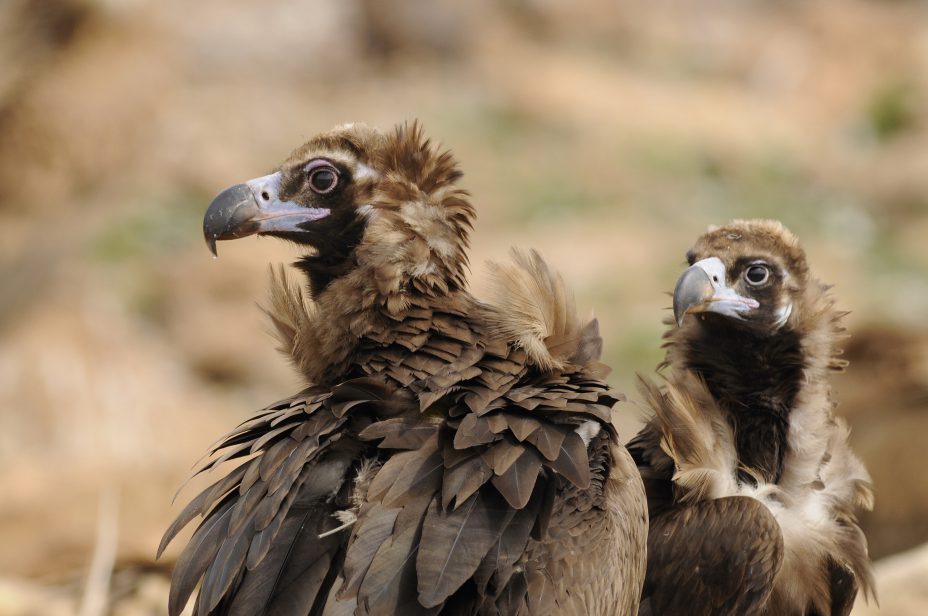
Cinereous Vultures are returning to the area burned over the summer at the Monfragüe National Park in Extremadura, Spain, which is home to one of the world’s most important breeding colonies for the species. Some pairs have even started building new nests way ahead of the usual time this task takes place.
Summer fire burns down Cinereous Vulture nests
This past July, a fire engulfed important natural areas at the Monfragüe National Park in Cáceres. The fire originated in Casas de Miravete on 14 July and in total burnt 398.23 hectares inside the National Park. As for the area burnt outside the National Park and included in the Special Bird Protection Area, 2,356.77 hectares were burnt.
The fire negatively affected several species, but the Cinereous Vulture suffered the most. At the time, several Cinereous Vulture pairs were almost at the end of their breeding period, with nestlings nearly ready to take their first flights and leave the nest. A total of 15 nests were completely destroyed by the fire, while 13 remained viable, according to the regional government of the Junta de Extremadura. Sadly, the species experienced further losses, with three young dying from this incident.
Nature and Cinereous Vultures reclaiming the burnt Monfragüe areas
Despite the detrimental effects of the fire at Monfragüe National Park, it seems that nature is bouncing back. Field teams are seeing new tree shoots and Cinereous Vultures returning to the area affected – they even witnessed a pair of Cinereous Vultures already beginning to build a new nest, which usually takes place in 3 months, around February. These signs give hope that this area, considered a natural jewel in Extremadura, will gradually return back to normal.
Cinereous Vulture population in Extremadura of international importance
It is no double that Spain is Europe’s stronghold vulture-wise, hosting around 90% of the European population. In terms of the Cinereous Vulture, the country hosts the world’s largest population and is home to approximately 2,500 breeding pairs, with more than half present in Extremadura.
To be precise, Extremadura is home to the two most important breeding colonies of the species in Europe, and these colonies are increasing. The latest census in 2020 recorded 461 breeding pairs in Sierra de San Pedro and 376 in the Monfragüe National Park, representing a 51.14% and 24.09% increase, respectively, compared to the 2016 census. In addition, the soaring Cinereous Vulture population in Extremadura makes it possible to support the conservation of the species beyond Spain!
Cinereous Vultures from Extremadura support Cinereous Vulture reintroduction projects
Every year, several Cinereous Vultures that hatch in Extremadura’s wild need rescuing and enter rehabilitation centres (Los Hornos and AMUS). Most birds return to the wild in Spain after they recover fully, while others are selected to support reintroduction projects in other European regions where the species disappeared.
For the past few years, the Junta de Extremadura has been generously donating Cinereous Vultures to reintroduction projects, including the projects in France and the Vultures Back to LIFE project in Bulgaria. They donated 69 Cinereous Vultures to the latter, and in collaboration with AMUS and us at the Vulture Conservation Foundation (VCF), all birds safely made their way to Bulgaria for their eventual release in the wild. Just a few years after the first release, the Cinereous Vulture returned as a breeding species in Bulgaria, successfully nesting in the Eastern (2021) and Western Balkan Mountains (2022), with more than 20 birds settled and 3-5 formed pairs. Without the booming nature of Extremadura and the support of the regional government, the successful restoration of the Cinereous Vulture to both countries would not have been possible.
The Cinereous Vulture efforts in Extremadura are a great example of best practice experience in conservation but also for generosity and contribution to the species in general. Thank you Junta de Extremadura!



